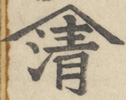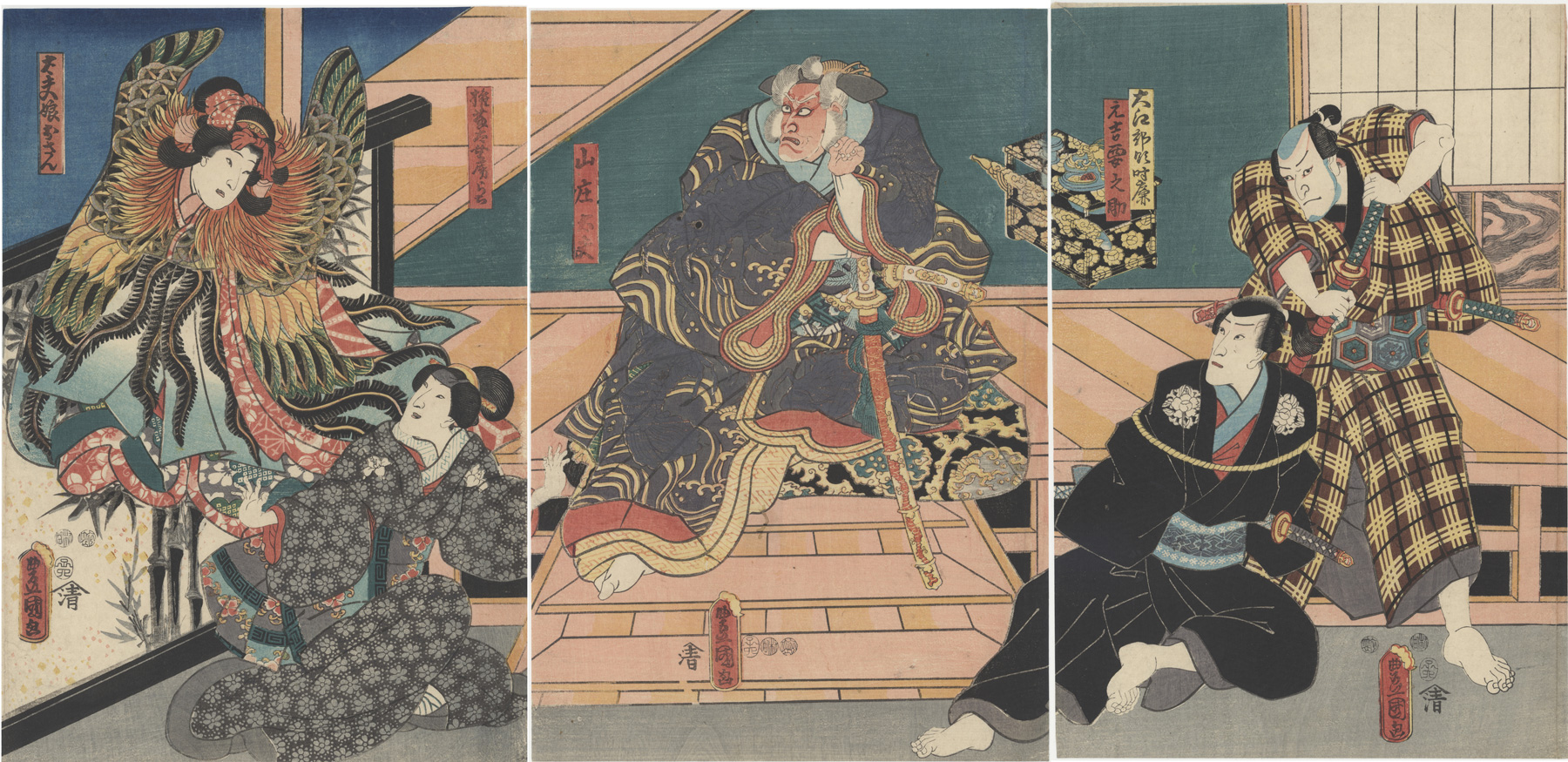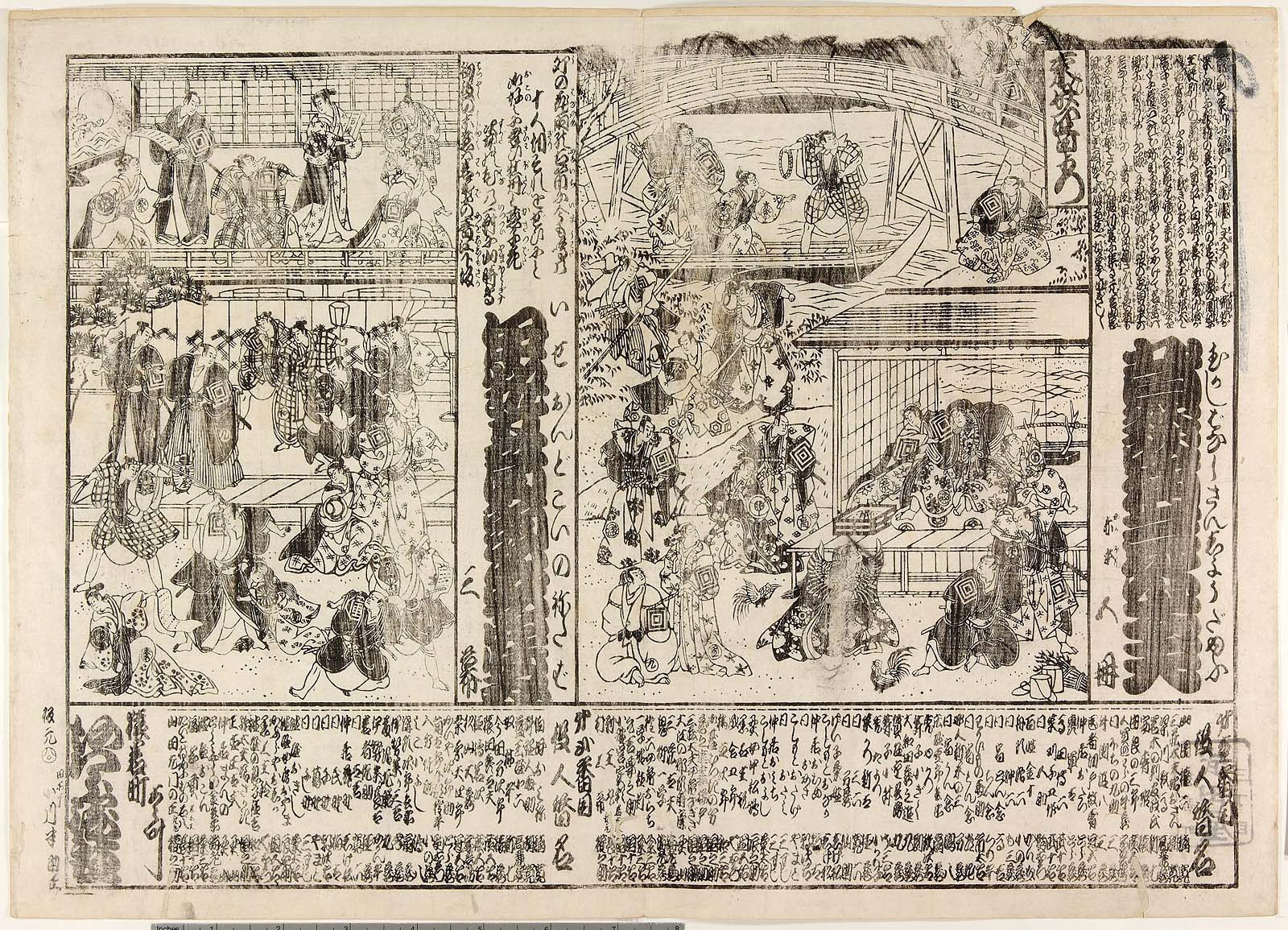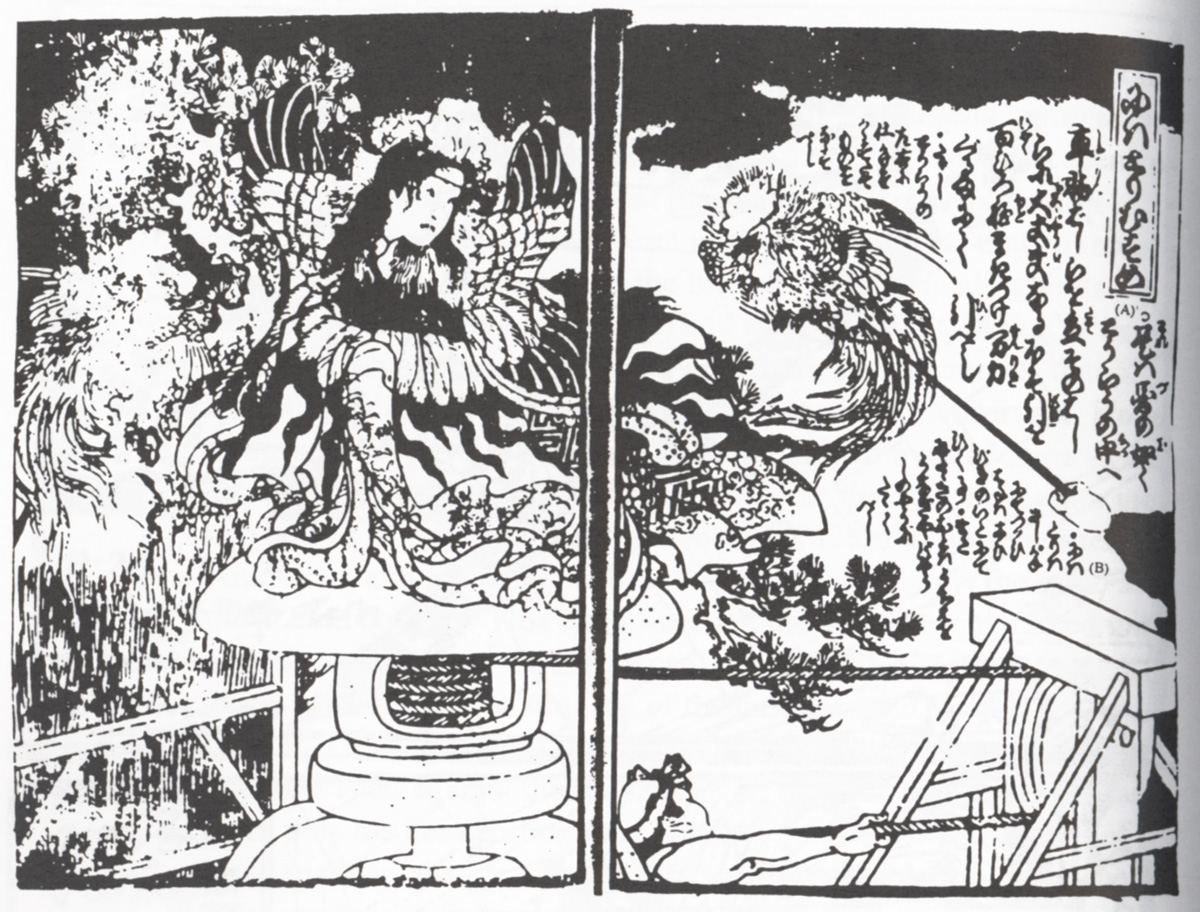About This Print
The highlight of this performance involving kidnap, slavery, revenge and redemption, is the afflicted Osan turning into a fowl, as she is depicted in the left panel, in the play The Old Story of Sanshō Dayū, as performed at the Kawarazaki theater in the 4th month of 1852. Osan will soon chew the ropes from Kanamenosuke (right panel), with whom she is in love, and then kill herself. The evil Sanshō Dayū, in the center panel, looks on. A number of kabuki plays have been written on the legend of Sanshō Dayū. A complete summary of one play (similar but not identical to the play depicted in this print) based on the legend is given below, as is a description of the "special effect" that is used to transform Osan into a chicken.right sheet: Asao Okuyama IV [see note under the below section "The Actors Pictured in This Collection's Print"] as Tokikiyo, Lord of Ōe; Ichikawa Danjūrō VIII as Motoyoshi Kanamenosuke [also translated as Motoyoshi Yonosuke]
center sheet: Ichikawa Ebizō V as Sanshō Dayū
left sheet: Iwai Kumesaburo III as Gondō Futoshi nyōbō rachi [kidnapped wife] or as Gonroku’s Wife (Nyōbō) Orachi; Arashi Rikan III as Dayū musume Osan [Dayū’s daughter, Osan]
While only the actor's roles are provided on the print (within the orange and yellow rectangular cartouches), the website of Ritsumeikan University provides the actors' names and the title of the play. (Although, please see note on the actor Asao Okuyma below.)
Turning Osan into a Fowl - Tricks of the Trade
Source: Theatre Survey 38:2 (November 1997), “What Really Happens Backstage: A Nineteenth-Century Kabuki Document," Samuel L. Leiter, p. 122
“As shown in the illustration, there is a central shaft in the stone lantern, with a thick rope coiled at least one hundred times around it, and this should be yanked via a pulley. However, there should be scenic pieces to hide the trick mechanism.” (B) “A [prop] chicken should be affixed to a long pole [sashigane] and its wings made to flap via a string. A fan should be flapped rhythmically to simulate the sound of flapping wings.” The technique is used in Yuranami Nato Sengen Chōjima (better known as Sanshō Dayū), in which a character has an affliction that turns her into a fowl. The illustration reveals a device for the actor to display some bizarre bird-like behavior when the pulley system causes him to spin wildly. The bamboo sashigane pole manipulated by a stagehand is one of kabuki’s most common devices, and is often used to introduce birds, butterflies, and the like.
The Play "Yura no Minato Sengen Chōja" 由良の港千長者
Authors: Takeda Koizumo II (later Takeda Izumo III), ChikamatsuHanji, Takemoto Saburōjbei, Miyoshi Shōraku, Kitamado Goichi. Also called Sansho Dayū, Tori Musume. Jidaimono. Nigyōj jōruri. Threeacts. Fifth month 1761. Takemoto-za, Osaka.
This play is based on the legend of Sanshō Dayū, firstrecounted in the sekkyō bushi (a religious musical narrative) Sanseu Dayū, and first dramatized inTakeda Izumi I’s Sanshō Dayū Gonin Musume(1727). Kabuki’s first productionwas in 1784 at Osaka’s Kado-za, while Edo first saw it in 1837 at theIchimura-za. Only the evens of Act II,“Tori Musume,” are still performed.
Masauji, head of the Iwaki family Oshū, has beenassassinated by a rōnin because of the ambitions of Tokikado, Lord of Ōe. Masauji’s wife, Mutsuki no Kata (or Kita noKata), accompanied by the faithful retainer Motoyoshi Kanamenosuke, flees withtheir children, Princess Anju and Tsushiomaru. The loyal Iwaki retainer Yamato Tamonoshin commits suicide because ofhis master’s death. Mutsuki no Kata getsas far as Ōgi Bridge in Echigo, where she is separated from her offspring by aslave dealer. The slaver is an old Iwakiretainer who is trying to raise money to form an army in hopes of restoring theIwaki clan, and does not recognize the family he is splitting up. Mutsuki no Kata is sent to Sado, and thechildren are sold to Master Sanshō (or Sanshō the bailiff), the very rōnin who murdered Masauji. He has become an avaricious millionaire whogets his name, meaning “Three Villas,” from the homes in different places inTango with which he has been rewarded by Tokikado. The children, now called Nobuo andWasuregusa, are engaged in back-breaking labor on his property in Yura Bay,where they haul salt from the sea and cut grass, being tortured if theycomplain. Kanamenosuke visits theyoungsters in hopes of saving them, but is captured by Sanshō’s nephew, YuramiSaburō. Recognized as an Iwaki, he issentenced to death by beheading, along with the siblings, when the first cockcrows at dawn.
Osan, Sanshō’s daughter – in love with Kananmenosuke, whomshe once met at a flower viewing – is, because of her father’s bad karma,afflicted with a disease that causes her to be transformed into a fowl beforedawn, when she flaps her wings and crows. She is thus called Tori Musume or “Chicken Girl.” There is a saying that if you buy onethousand white chickens, your daughter will become empress, but in the presentcase, Sanshō has bought one thousand chickens in hopes of his daughter’sstrange ailment. She hopes to saveKanamenosuke’s life by preventing her father’s thousand chickens from crowing,and runs around killing them, but cannot prevent herself turning into one ofthem and crowing. She chewsKanamenosuke’s ropes off and then kills herself. The children are set free and escape, and thesamurai confronts Sanshō. The latter,however, recognizes him as the child who was stolen from him years ago andrealizes that Masauji was his own master. Repenting of the crimes that he had committed (modori), he allows hislong-lost son to kill him. Kanamenosuketakes his own life to atone for having slain his father. The children head for Sada, where they arereunited with their mother.
The highlight comes with the vision of the mad Osan in theform of a fowl, a transformation effected largely by the use of a costume,revealed via bukkaeri, on which aunique feathered pattern has been dyed. The subject of a woman turned into a bird resembles that of Sage Musume.
The Actors Pictured in This Collection's Print
For profiles of the actors depicted in this print please see the article The Kabuki Actor.Print Details
| IHL Catalog | #1355 |
| Title (Description) | The Old Story of Sanshō Dayū Mukashi-banashi Sanshō Dayū 昔談柄三升太夫 |
| Series | n/a |
| Artist | Utagawa Kunisada I (1786–1865) |
| Signature |  |
| Seal | |
| Publication Date |  子四 1852 (Kaei 5), 4th month 子四 1852 (Kaei 5), 4th month |
| Publisher |  [Marks pub. ref. 468; seal no. 01-081] |
| Carver | |
| Impression | excellent |
| Colors | excellent |
| Condition | good - three separate sheets; not backed; minor mounting remnants verso; vertical folds on edges; crease upper right of right panel; repair to wormhole verso center panel |
| Genre | ukiyo-e; yakusha-e |
| Miscellaneous | |
| Format | oban triptych |
| H x W Paper | right sheet: 13 7/8 x 9 5/8 (35.2 x 24.4 cm); center sheet: 13 7/8 x 9 1/2 in. (35.2 x 24.1 cm); left sheet: 14 x 9 7/16 in. (35.6 x 24 cm) |
| Collections This Print | Art Research Center, Ritsumeikan University mai03f04 |
| Reference Literature | |




